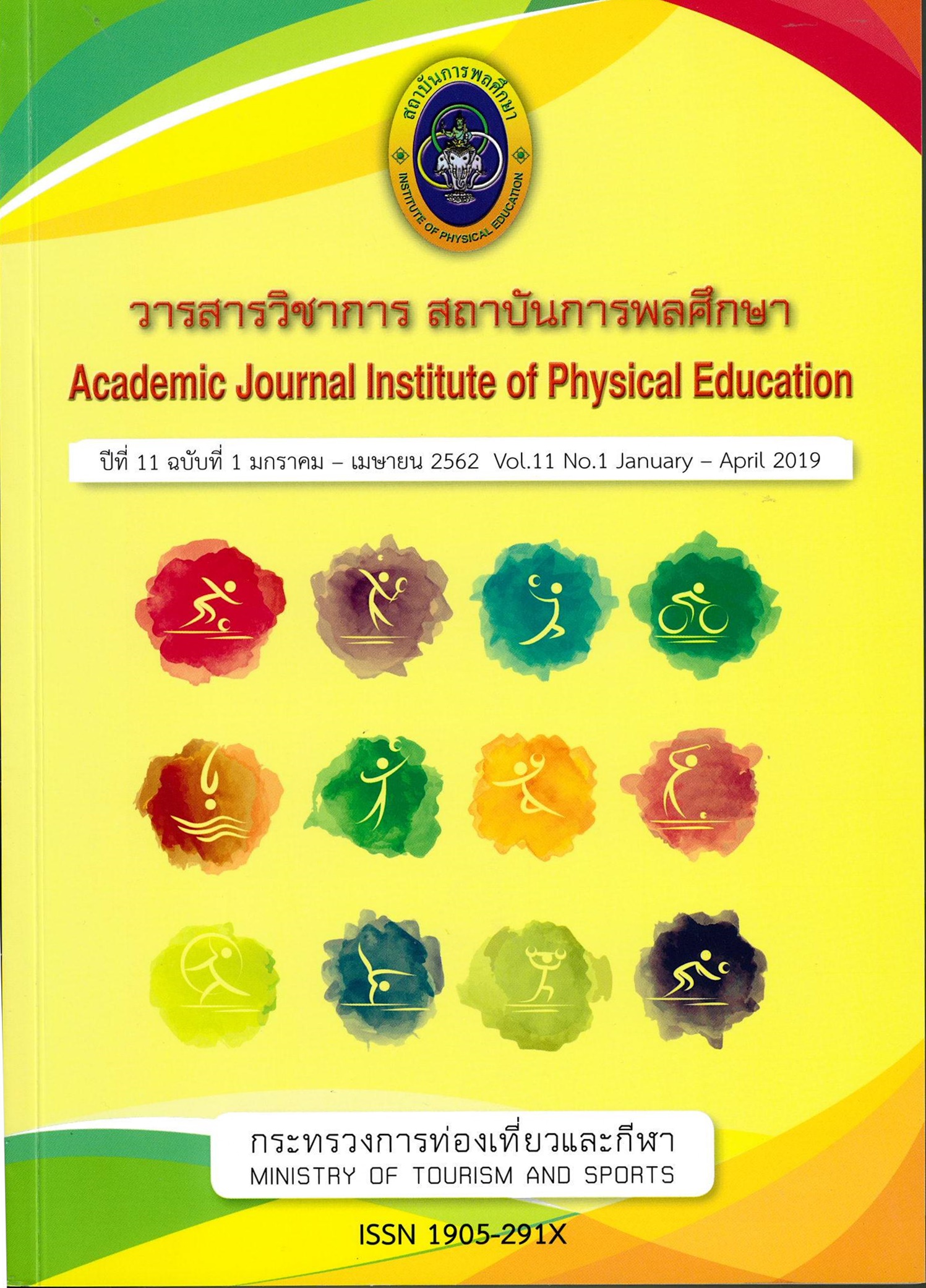Improvement of Physical Fitness for Balancing and Fall Prevention in Elderly
Main Article Content
Abstract
The purposes of this research were 1) to study risk factors for falls in the elderly and physical fitnessof the elderly 2) to develop a method for improving the physical fitness for balancing and fall prevention in elderly 3) to test the guidelines for improving the physical fitness for balancingand fall preventioninelderly4) toevaluate physicalfitnessof balancing and preventing falls in the elderly after their physical fitness improvement. The research was divided into3 phases.1) Studying therisk factorsof falls intheelderly and the physical fitness of the elderly 2) Creating approaches to improve physical fitness that would help them with balancing and preventing falls 3) Testing the guideline that help with balancing and preventing falls.Theresearchinstruments were Questionnaire, Guidelinetofocus group discussion, Senior FitnessTest, and Physical ActivityPlans.The data wereanalyzed byusing statistics, frequency, percentage,mean, standard deviation, paired samplet-testand content analysis. Theresearchfound that therisk factorsof falls intheelderly are deterioratinghealth, chronic disease, lack of proper care, accidents, and lack of exercise. The results from the first phase of the study as well as the health literacy and adult learning principles were used inthe preparationof the physicalfitness improvement plantohelp with balancingand
preventing falls. The result of the evaluation found that the plan was highly appropriate. The result of the physical fitness test and the development of the guideline had been well adapted to the real practice while working with all sectors in the community. The evaluation of the physical fitness on balancing and preventing falls showed improvement in the physical fitness of the elderly participating in the program from before the research
Article Details
The published article is a copyright of the Academic Journal of Thailand National Sports University. The passage appeared in each article in this academic journal is a perspective of each author which is not related to the journal. Each author is required to be responsible for all components of his/her own article. If there are any mistakes, each author must be responsible for those mistakes on his/her own.
References
คณะกรรมการส ่งเสริมและประสานงานผู้สูงอายุแห ่งชาติ. (2545). แผนผู้สูงอายุแห่งชาติ ฉบับที่ 2 (พ.ศ.2545–2564). สำนักนายกรัฐมนตรี. กรุงเทพฯ.
แดนเนาวรัตน์จามรจันทร์,จิตอนงค์ก้าวกสิกรรม และสุจิตรา บุญหยง. (2548).การศึกษาเรื่องการทรงตัวและหกล้มในผู้สูงอายุไทย. กรุงเทพฯ: สำนักงานกองทุนสนับสนุนการวิจัย (สกว.) และสำนักงานกองทุนสร้างเสริมสุขภาพ (สสส.).
แผนพัฒนาเศรษฐกิจและสังคมแห ่งชาติฉบับที่ 12 (พ.ศ. 2560–2564). (2559, 29 ธันวาคม). ราชกิจจานุเบกษา. เล่ม 133 ตอนที่ 115 ก. หน้า 1-215.
มูลนิธิโรคกระดูกพรุนแห่งประเทศไทย ในพระอุปถัมภ์ของสมเด็จพระเจ้าพี่นางเธอ เจ้าฟ้ากัลยาณิวัฒนา กรมหลวงนราธิวาสราชนครินทร์. (2554). ชุดความรู้เบื้องต้น คู่มือการป้องกันโรคกระดูกพรุนสำหรับประชาชน. กรุงเทพฯ: Nextstep D-sign.
วิชัย เอกพลากร (บก.). (2553). การหกล้มในผู้สูงอายุ. รายงานการสำรวจสุขภาพประชาชนไทยโดยการตรวจร่างกายครั้งที่ 4 พ.ศ. 2551-2552. สำนักงานสำรวจสุขภาพประชาชนไทยสถาบันวิจัยระบบสาธารณสุข. นนทบุรี.
วิภาวี ลักษณากร. (2554). ผลของการออกกำลังกายต่อความหนาแน่นของมวลกระดูก การหกล้ม ปัจจัยเสี่ยงของโรคหลอดเลือดหัวใจ และค่าใช้จ่ายเกี่ยวกับการดูแลสุขภาพในผู้หญิงสูงอายุ. มูลนิธิโรคกระดูกพรุนแห่งประเทศไทย. สืบค้นเมื่อ 11 กุมภาพันธ์2559 จาก http://www.topf.or.th/read_hotnews_detail.php?dID=52
วิภาวี หม้ายพิมาย. (2556).การหกล้มในผู้สูงอายุ..ปัญหาที่ไม่ควรมองข้าม. ภาควิชาการพยาบาลรากฐาน คณะพยาบาลศาสตร์ มหาวิทยาลัยมหิดล. สืบค้นเมื่อ 15 กุมภาพันธ์2559 จาก http://www.ns.mahidol.ac.th/english/th/ns_academic/56/08/old_th.html
ศรีวรรณ ปัญติ. (มปป.). คู่มือปฏิบัติการ การตรวจสมรรถภาพทางกายในผู้สูงอายุ. ภาควิชากายภาพบำบัด คณะเทคนิคการแพทย์มหาวิทยาลัยเชียงใหม่.
สำนักงานสถิติแห่งชาติกระทรวงเทคโนโลยีสารสนเทศและการสื่อสาร. (2550).รายงานการสำรวจประชากรสูงอายุในประเทศไทย พ.ศ. 2550. สืบค้นเมื่อ 20 มกราคา 2559 จาก http://www.servicenso. go.th/nso/nso_center/project/search_center/23project-th.htm
อุดม เพชรสังหาร. (2557). การหกล้มในผู้สูงอายุ. โลกวันนี้วันสุข, 10(471), 46.
เอกศักดิ์ เฮงสุโข. (2557). ศักยภาพของชุมชนในการสร้างเสริมสุขภาพด้วยการการออกกำลังกายของผู้สูงอายุ. วารสารวิจัยมหาวิทยาลัยราชภัฎสวนดุสิต, 3(10), 129-142.
Campbell, A.J., Borrie, M.J., & Spear, G.F. (1989). Risk factors for falls in a community-based prospective study of people 70 years and older. Journals of Gerontology, 44(1), 12-17
Chang, J.C., Morton,S.C.,Rubenstein,L.Z., Mojica, M.M.,Suttorp, M.J.,Roth,E.A.,etal. (2004). Interventions for the prevention of falls in older adults: systematic review and meta-analysis of randomised clinical trials. British Medical Journal, 328(1), 1-7.
Edelberg, H. K. (2001). Fall and function: how to prevent fall and injuries in patients with impaired mobility. Geriatrics, 56(3), 41-49.
Fuller, G.F. (2000). Fall in the elderly. American Family Physician, 61(7), 2159-2168, 2173-2174.
Knowles, M. (1984). The Adult Learner: A Neglected Species. (3rd Ed.). Houston, TX: Gulf Publishing.
Lipsitz, L.A., Jonsson, P.V., Relley, M.M., & Roesner, J.S. (1991). Causes and correlates of recurrent falls in ambulatory frail elderly. Journals of Gerontology, 46(1), 14-22.
Nutbeam, D. (2008). The evolving concept of health literacy. Social Science & Medicine, 67, 2072-2078.
Nutbeam, D. (2009).Literacy, Health Education, Health Literacy and Health Outcomes How do they fit? UN Economic and Social Council, Regional Meeting on Promoting Health Literacy, Beijing, China, 29-30 April, 2009.
Shumway-Cook, A. & Woollacott, M.H. (2001). Motor Control: Theory and Practical Application. Philadelphia: Lippincott Williams and Wilkins.
Studenski, S., Duncan,P.W., & Chandler, J. (1991).Postural responses and effector factors in person with unexplained falls: results and methodologic issues. Journal of the American Geriatrics Society, 39, 229-234.
Tinetti, ME. (1986). Performance oriented assessment of mobility problems in elderly patients. Journal of the American Geriatrics Society, 34, 119-126.
Tinetti, M.E., Speechley, M. & Ginter, S. (1988). Risk factors for falls among elderly persons living in the community. New England Journal of Medicine, 319(26), 1701-1707.
Woollacott, M. (1986). Gait and postural controlonthe aging adult. In:Bles W. Brands T.eds. Disorders of posture and gait. Amsterdam: Elsevier. 325-336.
World Health Organization(1998). Health Promoting Glossary.Retrieved February27,2014 from www.who.org.


